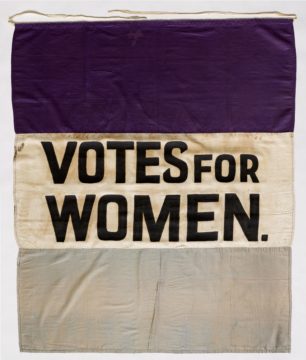by Rebecca Baumgartner

A few years ago when I was working at a large corporation, I walked into the lobby one morning in March, bleary-eyed and clutching a thermos of coffee, and was startled to see an enormous pink banner covered in flowers, proclaiming in a swirling cursive font that the company was “honoring women” as part of International Women’s Day (IWD).
The aesthetic of the banner was less “recognition of female professionals” and more “eight-year-old girl’s diary.” It would be hard to come up with a display that was more alienating and patronizing to a group of adult women.
In a piece in Feminist Current called “No more cupcakes! A call to action on International Women’s Day,” Natalie Jovanovski and Meagan Tyler discuss how this is not a coincidence. They refer to this infantilizing way of honoring women as “cupcake feminism” and discuss it in the cultural context of employers’ penchant to trivialize IWD under the assumption that “women = frivolity.”
That Infamous Pink Banner stayed up there all month, because it was Women’s History Month. So every morning for a month, the first thing I saw upon arriving at work was a reminder that my employer wanted me to feel appreciated by showing me a vision of hyper-femininity that – even as a cis, straight woman – does not come even remotely close to how I see myself or present myself to others in my personal life, much less at work, where women have fought for decades to be taken seriously.
***
I already knew what IWD was by that time, but only because of a conversation I’d had several years previously. I was in graduate school at the time and chatting with my Russian friend, who asked if I was doing anything special for March 8.
“Why – what’s on March 8?” I asked, confused.
“It’s International Women’s Day – don’t you guys celebrate that here?” she said, equally confused.
From our subsequent conversation, I learned that in Russian culture (as well as in many other cultures, I later learned), IWD has a status similar to Mother’s Day, with women commonly receiving gifts and flowers from loved ones. Hearing my friend describe the holiday, I had mixed feelings, just as I do about Mother’s Day itself. I enjoy beautiful flowers and gifts, when given sincerely, as much as anyone else, but I also feel uncomfortable with putting women on a pedestal, and I bristle at how these holidays give everyone a false sense of progress. “Now that we’ve honored all the women, let’s go back to paying them 82 cents on the dollar! See you next year!”
When celebrated in this way, IWD is a show of appreciation devoid of real action or change, designed to let men – and the institutions that are primarily still run by men – broadcast their progressiveness. It’s like getting a box of chocolates instead of more help around the house. A pat on the head instead of a promotion.

Most Americans’ exposure to IWD, to the extent they’re exposed to it at all, consists of things like newsletters from their company’s human resources department, hashtags on social media, Google Doodles, promotional emails enticing women to treat themselves to some self-care with a side of consumerism, and publicity stunts and marketing gimmicks (like the decision of Hershey’s to put “HER-SHE” on their chocolate bar wrappers in certain countries; the wrappers also feature images of various “SHEROES” – I am rolling my eyes as loudly as you are).
The meaning of IWD, at least in the U.S., is largely mediated by for-profit institutions, and its impact is measured primarily via the things people say about it on social media.
***
This sorry state of affairs would be nothing more than another example of the disappointing “Hallmark-ification” of significant days, if it weren’t for the fact that IWD has a real history intended to mean something more than just appreciating women.
In fact, IWD began as a labor movement and was formative in the development of socialism. Far from being an ersatz corporate Mother’s Day, the genesis of IWD was the result of the natural intersections between the women’s suffrage movement, the fight for female workers’ rights to equal pay and equal treatment, and the anti-war movements of the early 20th century.

IWD’s history began in 1909, with the Socialist Party of America. The party held the first National Woman’s Day as part of their campaign for women’s suffrage in the U.S. (they would not reach this goal until 1920). Mass meetings were held around the country, and National Woman’s Day was observed in the U.S. every year until 1913.
Meanwhile, the International Socialist Congress in Europe took note of the U.S. observance and worked to create an international version of the holiday, and some version of a “Woman’s Day” began to be observed in various countries on various dates. World War I further catalyzed support for the women’s movement, and on March 8 (February 23 Old Style) 1917, women in Petrograd (now St. Petersburg) took to the streets and protested food shortages, demanded better living conditions for their families, and advocated for peace.
Their demonstration ultimately helped give rise to the Russian Revolution of 1917. In honor of these women’s activism, the date of the new IWD was formally established as March 8 in 1921, and the holiday was later sponsored by the U.N. in 1975.
Knowing the history behind IWD is important because it brings into focus the ways in which the fight for women’s rights has been inextricable from resistance against capitalism, war-mongering, and the mistreatment of workers. All of these issues are of a piece, but they have been fractured. It’s rhetorically convenient for governments and other institutions to have women to think their struggles are separate from and unaffected by aggressive profit motives, militarism, and labor practices that stack the deck in favor of employers.
To give just one example of how all of these issues are interconnected: If Americans are led to believe that paid parental leave, which all OECD countries other than the U.S. guarantee their workers, is purely a matter of economic policy, they will fail to connect the dots linking the lack of paid parental leave with the disparity in employment outcomes and lifetime earnings for women (and their families). An issue that by its very nature has multiple dimensions of potential harm or benefit is reduced to a single dimension. As a result, it becomes harder to see how the lack of paid parental leave is part of a larger project in which the U.S. devalues care work, which is disproportionately done by women.
***
The tone of IWD has shifted from women using their own agency to demand societal change, to institutions condescending to “honor” women (and, of course, sell them things).
The word “honor” itself has connotations of passivity; someone being honored is not supposed to demand anything. They receive whatever is given to them as a gift. “Honor” also implies that women need to have done something extraordinary in order to be worthy of such recognition, rather than just be a human being who deserves to be treated equally because they’re a human being.

But no one needs to be an inspiration to others before deserving equal treatment. Yes, we need more female CEOs, but we shouldn’t turn IWD into an awards program where only women who have met society’s standards for success are deserving of our attention. Focusing overly much on individual women, no matter how inspirational, can convey the message that addressing gender disparities is a matter of individual character, when in reality it’s a matter of fixing the systems and structures that continue to privilege men over women.
“Honoring” women is beside the point. We don’t need to sanctify womanhood; we need to recognize women’s personhood and make sure the system stops getting in their way.
The women who mobilized in 1917 to demand an equal voice in politics, fair pay for their work, enough food to feed their families, and safety for their sons and brothers and husbands did not want to be “honored.” They weren’t waiting around to be served tokens of appreciation, nor did they expect the system to change on its own. What they wanted was more meaningful and active than that, more challenging to the status quo, and harder to encapsulate in slogans and stereotypes. They wanted nothing less than the transformation of an unjust world into a slightly fairer one. And that core desire has not changed since 1917, even if the specific issues in question have.
***
To broaden its appeal, IWD has had its complex, progressive, and politically subversive history glossed over and even rewritten to make it more palatable to a consumer audience.
Despite the fact that IWD originated in America’s own socialist and labor movement, middle-class feminists in the U.S. felt (and continue to feel) it better to avoid the political third rail of socialism. With Cold War anxiety at its peak after World War II, it was convenient to have a myth about IWD’s origins that could sell Americans on a concept tainted by association with the USSR.
The myth, which you can still find repeated in multiple online sources, goes like this: On March 8, 1857, female garment workers from various factories in New York City supposedly went on strike to demand better working conditions and the right to vote. This invented story, which didn’t surface until the 1950s, with its removal of all references to the Soviet Union and socialism (not to mention pacifism), can ultimately be traced back to a French publication, but in effect, the story had the result of making IWD more palatable to Americans.
As the U.S. labor movement weakened over the decades, even the invented story of the garment workers going on strike would be scrapped, eventually being replaced with a generic, apolitical day of flowers and cupcakes that wouldn’t rock the capitalist boat.
***
Nowadays, IWD is used by businesses as a way to – if we’re being charitable – retain and appreciate female workers, or – if we’re being more cynical – pay lip-service to the idea of gender equality in the workplace without actually implementing meaningful changes, like wage parity, that would force organizations to put their money where their mouth is.
For example, Hershey, whose cringey “HER-SHE” wrappers I mentioned earlier, has set itself the goal of achieving “aggregate dollar-for-dollar pay equity for salaried employees worldwide” by 2025, which is admittedly more than some companies are doing.
But it’s also one of those statements like “I plan to stop my problematic drinking next year” that sends a conflicted message, at best. It highlights the fact that the pay disparity exists today and has existed without being addressed all this time; that despite being aware of it now, Hershey is nevertheless planning to take two years to fix it; that the solution would only apply in “aggregate” (whatever that means); and that apparently only salaried women deserve to be paid as much as their male peers.
This is weak. It’s only brag-worthy in comparison to the dismally low bar set by other American corporations. Associating this poorly defined, completely unenforceable, and heavily qualified promise with IWD, while celebrating “SHEROES” on candy wrappers, comes across as insincere pandering.

And that’s just how corporations position themselves outwardly to the public. When it comes to recognizing their own employees, corporate IWD efforts exhibit all the tone-deaf posturing, hypocrisy, and cringe-inducing failures of empathy you would expect from corporate America, with some instances as egregious as the “Women’s Appreciation” episode from The Office.
For example, in the name of celebrating IWD, female employees have reported being given vouchers for pedicures and gift bags full of makeup. Multi-level marketing schemes, which are notoriously financially devastating to and predatory against women, use the language of IWD and “boss babe” feminism to promote their products on social media. Employers and HR departments who don’t understand irony have asked women to give talks on the gender pay gap during the week of IWD – for free. Or they’ve expected female employees to do the (often unrecognized) work of organizing IWD events, effectively adding to the “extraordinarily long list of their unpaid responsibilities.”
***
To avoid a Michael Scott-esque PR faux pas, some corporations may decide to hire outside help. If they do, they’re likely to go with Aurora Ventures, a “purpose-driven” consulting firm that helps corporations achieve a more “female-friendly” slant to their branding. If you search for “International Women’s Day,” you’re likely to be led to the private website internationalwomensday.com, which Aurora Ventures owns. As the top Google result, appearing above the UN’s own page, the site presents itself as the authority on IWD.
This is worth an eyebrow raise, if for no other reason than Aurora Ventures’ clients include mega-corporations such as Amazon, BP, Goldman Sachs International, Shell International, arms manufacturers BAE Systems and Lockheed Martin, multilevel marketing scheme Avon, Big Pharma companies Novartis and Eli Lilly & Co., offshore drilling company SLB, and many other “morally dubious” companies – in other words, “an endless list of companies taking up space as they ‘celebrate’ the female workers whom they exploit and underpay throughout the year,” as Ugandan feminist journalist Jackline Kemigisa puts it.
Aurora Ventures provides these companies with IWD-themed social media imagery, selfie cards, posters, speech-writing resources, corporate talking points, and merchandising such as cupcake decorations (naturally!) and wristbands. Notably, they promote their own annual theme for the day, which is deliberately different from the UN’s theme, presumably in an attempt to make the talking points more palatable to corporate audiences.
For instance, this year, the UN’s theme is “DigitALL: Innovation and technology for gender equality,” which focuses not only on women’s access to the internet around the world, but also on protecting the rights of girls and women in digital spaces and closing the gender gap in STEM achievement. By contrast, Aurora Ventures’ IWD theme is #EmbraceEquity, which apparently involves a whole lot of stock photos of women creepily giving themselves hugs in between choppy lines of embarrassingly bad copywriting that read like an ominous meditation prompt (or a Daft Punk song): “Think it. Be it. Do it. Value it.”
The difference between the two is that the UN theme lays out a specific, defined problem and concrete ways of addressing it; Aurora Ventures’ theme is vapid and vague enough to be shaped into whatever their corporate partners need it to be, which is the entire point.

As marketer Ebony Breen wrote on LinkedIn last year, “A global day of intersectional activism becomes a day of career advice for privileged women.”
Aurora Ventures has been called out on their attempts to hijack the meaning of the day, and in response, their IWD website states some variation of “There is no right or wrong way to mark IWD” on nearly every page, until it starts to seem like this accusation really bothers them. But contrary to the snotty defensiveness of their claim that “all IWD action is valid,” the problem with turning a day grounded in activism and socialist principles into hashtags and bracelets has nothing to do with comparing equally valid interpretations of IWD, or about the fact that the meaning of the day has changed over time, which is only to be expected.
The problem comes from the way a private venture has deliberately co-opted a public day of recognition, attempts to give some of the most problematic corporations in the world a handy way to appear more female-friendly to the public without having to make any changes to the way they conduct business, all while trying to convince us that their efforts are as valid as the UN’s more inclusive and meaningful initiatives, and that the most impactful way the day can be recognized is via corporate action and capital accumulation.
***
Writing about why she no longer celebrates IWD, Jackline Kemigisa says: “[IWD] is understood as an opportunity to repackage women’s blood, sweat and achievements, despite oppression, into bite-size and commodified ‘inspiration’ that can be assigned a market value.”
She goes on to say:
“…even today, on a continent where nearly all indicators of women’s collective well-being remain dismal, despite a staggering $53bn in aid spent to support gender equality and women’s empowerment, NGOs still spend time making lists of women to invite to festive events and give awards to on 8 March.
In countries like Uganda, poor women will be ferried from villages to towns to provide an audience for this day of celebration before returning to those villages, where they live in poverty. Why not simply redistribute the money for such events to these impoverished women? Why wasn’t that $53bn put directly into such women’s pockets in the first place?”

A representative for the Women’s Strike, an initiative in which women go on strike from both paid and unpaid work on March 8, says, “We don’t want a world where women are ruthlessly exploited by corporations only for this to be sold back to them as empowerment.”
“The Women’s Strike defies the idea that all women need to do is tell our stories and speak out,” their website states. “We are exhausted from telling the same story, over and over again. We need action.”
***
So, in practical terms, what does that action look like? Although by no means exhaustive, here are a few steps corporations can take:
- Conduct a formal pay audit and then – here’s the crucial part – publish the results to employees, shareholders, customers, and other stakeholders. Based on today’s wage gap, women currently lose out on $406,280 over the course of a 40-year career compared to their male counterparts (the “lifetime wage gap”). Don’t just stop at the audit; close the gaps you identify with actual dollars and cents in women’s paychecks. And you can totally do this now, by the way. Not everything needs to be a roadmap for the future, especially if your car is stuck in a ditch right now and there’s a clear way forward.
- Disclose the budgeted salary range for your open positions, and do not ask applicants about their salary history. When the salary range for a position is secret, it’s women who lose. Transparency in job posts helps cut off the cause of pay disparity at the source and prevents basing a woman’s current salary on salaries at past jobs where she was underpaid – effectively trapping her a cycle of being perpetually underpaid. There is truly no good reason to ask for applicants’ salary histories, ever.

- Offer paid parental leave to new parents and – once again, here’s the crucial part – create an environment in which people feel comfortable and supported in actually using the amount of leave they’re allotted. Study after study shows that offering paid leave will increase the retention of women in the workforce and improve their long-term financial stability. This can be a crucial part of getting women who quit their jobs during the pandemic back into the labor force.
- If you host an IWD event and invite outside speakers, pay them for their time. Make sure any internal celebrations don’t turn into more office housekeeping (un-promotable tasks) for female employees.
And here are a few steps individuals can take:
- Push back if you’re a woman and are asked to do something for IWD for free, or on top of your normal job duties. And if you feel you were asked to do so solely because you’re female, remember that it’s illegal for employers to assign work by gender.
- If you suspect there are pay disparities at your workplace, be willing to share your salary with others and ask coworkers if they’d be comfortable discussing their salary with you. Remember, it’s your right to talk about pay with your coworkers (whether or not you’re part of a union). It’s also illegal for employers to retaliate against employees for discussing compensation with each other, and it’s illegal for them to have a policy prohibiting such conversations. These are basic, and very important and hard-won, rights that not many people (including employers) are aware of, so educate yourself.

- If you’re so inclined, join a Women’s Strike or other IWD event. Ask your employer about offering paid parental leave. Speak up if you witness bad behavior and don’t engage in bad behavior yourself. Norms are often created before policies catch up, and individuals’ casual interactions are how norms are established.
- If you’re the marketing/HR/social media person in charge of approving physical signage or website and social media content surrounding IWD at your company, take personal responsibility for promoting the day and recognizing female employees in ways that do not reinforce stereotypes. It’s incredibly common for IWD materials to include hearts, swirly text, pink in every conceivable shade (despite the fact that IWD’s official color is purple), and flowers. So, so many flowers. You don’t have to go full-on angry Teutonic socialist woman waving a red flag, but by the same token, remember that you’re not decorating for a baby shower. This is not Valentine’s Day or Mother’s Day. Don’t add to the problem.
